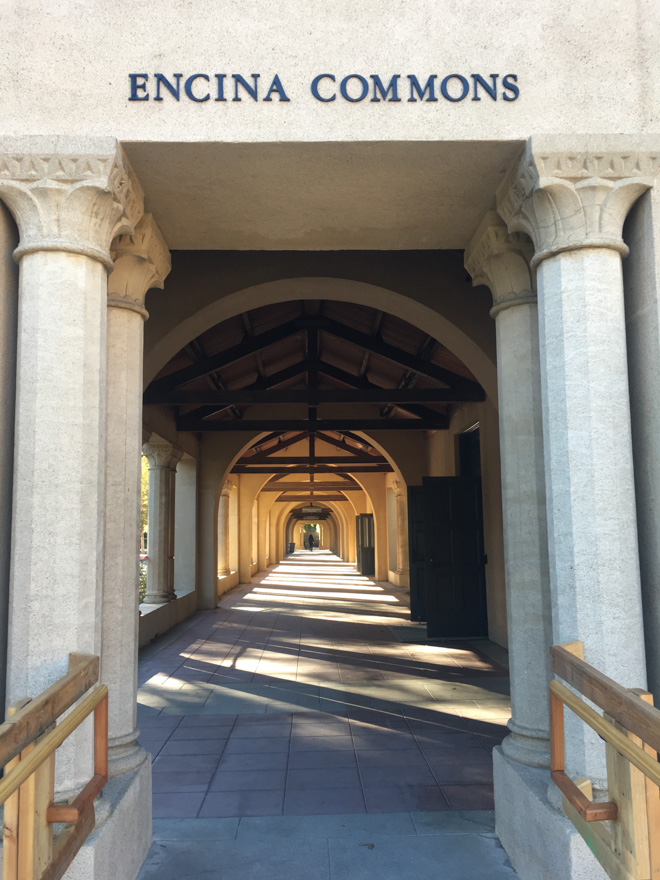On the walls inside of the Center for African Studies (CAS), there are photo portraits of Stanford students with words such as “love” and “happiness” written across their bodies, symbolizing what CAS means to them. And on Thursday, students carried those portraits from CAS’ old space in Encina Commons to a new space, within the same building, near the corner of Arguello Way and Crothers Way.
The transition, over two years in the making, according to CAS staff member Isi Umunna ’19, brings up questions about CAS’ function at Stanford and about the various roles it plays as a community center and academic center.
The move coincides with the relocation of several other Stanford Global Studies (SGS) entities that are moving into Encina Commons and a portion of Encina hall, according to SGS Executive Director Kate Kuhns.
“This is part of a larger University-level effort that has been in the works for many years to renovate Encina Commons to create a centrally located, academic hub on campus for international studies within the Encina Quad.” Kuhns said.
The move comes after nearly two years of planning and meetings; when it was first announced, students pushed back. The Daily published an op-ed titled “Don’t put Africans in the basement” by Mina Shah ’17, who implored that CAS stay put.
Shah argued that moving CAS would prevent it from adequately serving the 350 students it typically does and would negatively affect the sense of community that exists there.
At first, students pushed to instead have CAS be recognized as a community center and move it into its own, bigger space. Many felt like CAS was already a de-facto community center, providing a space for minority students on campus to gather together and share community.
“We found a community in this space; we cultivated this community, yet the University has taken the stance to decidedly not admit this — this magic, this beauty,” said Brian Fleischer, a member of CAS staff. “If we were officially recognized as a community center, it would give us the mandate, the authority to demand for a bigger space; our funding would increase; we would be able to do more things for our community.”
Officially, CAS is an academic center, under the umbrella of SGS. But according to members of CAS, unofficially, the center is a place where students can go to plug into the African community at Stanford. For Umunna, CAS has been a place of solace on campus.
“My first week at Stanford, I walked into CAS, and I sort of never left,” she said. “I think that it’s been such a supportive space. It’s easy at Stanford to feel lost and alone and feel like you don’t have a connection to anything, especially as an international student.”
Although many students say the center serves a supportive role, Umunna and other students did not get very far when they approached the administration and asked to make CAS an official community center.
“Stanford is a place that touts diversity and inclusion, but when it came to CAS being recognized as a community, the common dialogue was that ‘we love that you have a community; we love that you do all these things for these people, but CAS is not a community center; it is an office — we expect you to do the labor, but we don’t want to make it a space suitable for that,’” Umunna said. “That’s my personal opinion. It’s not my opinion as a CAS staff.”
Vice Provost of Student Affairs Susie Brubaker-Cole said that, after hearing desires from several student groups on campus to have “a more formal presence and set of supports on campus,” she asked a group of faculty, staff and students to convene last spring to study how the University should approach ensuring that all student groups on campus feel “belonging, recognition and validity.” Their work is expected to be completed in the winter.
For now, CAS remains an academic center, not a community center. According to Kuhns, the new space has the same overall square footage as the former one, with a “much better-configured layout.” And throughout the process, CAS student leaders were able to play a role in designing the new space, including selecting furniture and choosing new technology.
On Thursday, faculty and students marked CAS’ move into its new space with music and food from across the African continent. In the process, student leaders were given freedom to design the space the way they saw fit.
According to Fleischer, the hope is that, although CAS is in a new space, its spirit of community will continue to thrive. Already, parts of the old space have been incorporated into the new. The same portraits are on the walls and tables — students from across the African continent and beyond, with words written across their bodies in Sharpie: Happiness. Always Welcome. Connection. My Forever Family.
Contact Adesuwa Agbonile at adesuwaa ‘at’ stanford.edu.
